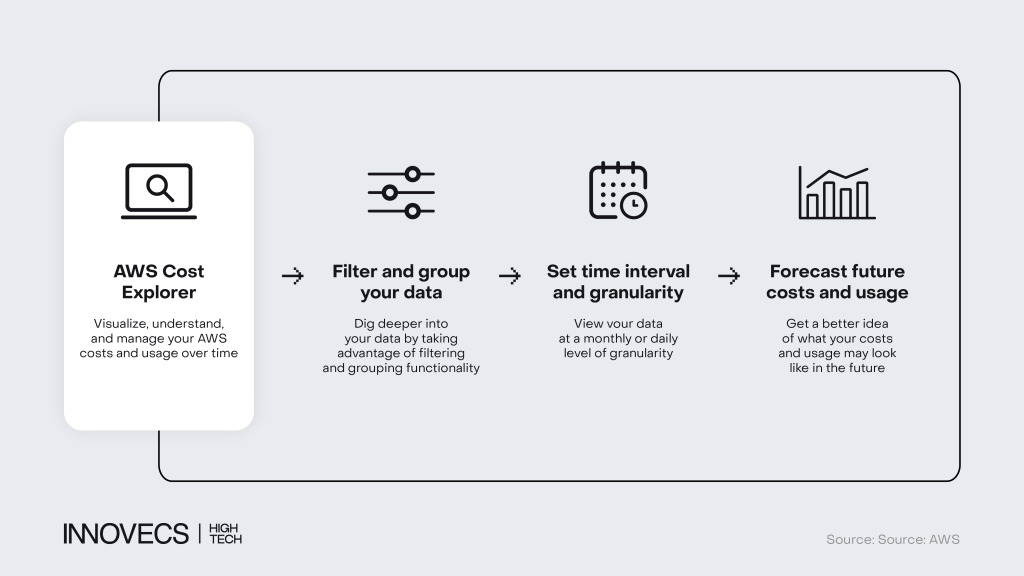
Have you ever wondered about how the HealthTech sector is reshaping patient care without letting costs spiral out of control?
The answer lies in three words: cloud cost optimization. This isn’t just some tech lingo; it’s a pivotal shift in how healthcare technology is managed.
Picture this: a strategy so finely tuned that every cent of your cloud spending is working hard towards your organization’s objectives. It’s about taking a magnifying glass to every resource used, questioning its value, and making choices that smartly balance cost against efficiency.
Imagine it as giving your cloud finances a regular health check-up, ensuring every dollar is spent wisely, and actively contributing to your mission in HealthTech.
Now, let’s ponder over how this strategy truly revolutionizes HealthTech. The crux of the matter is simple: it’s about cutting away the unnecessary fat in cloud spending.
We’re not just talking about balancing numbers on a spreadsheet; it’s about placing patient care and the future of healthcare at the forefront. In the grand scheme of things, effective cloud cost management in tech health isn’t just a wise decision—it’s a leap toward fostering a healthier, more tech-forward future.

You’ve probably heard the term cloud cost optimization thrown around a lot lately, especially in HealthTech circles.
But what’s all the fuss about? Let’s break it down.
At its essence, it’s about taking a magnifying glass to your cloud spending. Why? To make sure every single dollar is pulling its weight and making a real difference.
It’s not just about slashing costs left and right; it’s about being smart with your cloud usage, ensuring you’re not overpaying while still getting the most out of the technology.
Effective cloud cost management is non-negotiable. You can easily keep your healthcare operation financially sound and efficient. All you just need is to look into cloud cost management through multiple sectors.
There are several reasons for cloud cost management. The top three crucial reasons for you:
- Financial stability. Why would you pay more than you need? It’s a very simple calculation to look into while you’re on the cloud cost optimization mission. For example, you’re keeping your patient data only in the cloud, but you’ve enabled a package of running apps. So, you’re paying for the things that you’re using. So, if you properly manage your cloud usage, it will spare critical funds to allocate towards other technical or healthcare operations.
- Resource Optimization. We all use cloud-based tools for storage space, computing power, or software services. But we hardly know the limit of our usage. However, you must identify the services and resources you’re using and with which frequency/capacity you’re expending on them. Otherwise, you might have extra resources that you never need to use but are paying a great amount for them annually. Thankfully, cloud cost management will help you from such trouble.
- Risk mitigation. If you don’t calculate the overall expenditure of your cloud cost, it can create a lot of chaos for you. Always try to mitigate financial risks associated with cloud spending. Thereby ensuring that your investments are secure, predictable, and aligned with organizational goals.
The key strategies for cloud cost optimization involve a combination of innovative techniques, like right–sizing, automated scaling, cost monitoring and governance, as well to keep an eye on your infrastructure evaluation, and multi-cloud approaches. Each of these strategies plays a vital role.
Let’s decode some of the top recommended strategies:
- Regular Audits: The Financial Health Check-Up. Regular audits of your cloud usage are paramount. Without these audits, you can’t track down where you might be spending a bit too freely. So, review your cloud settings and ask yourself, “Do we need this? Is there a better way?” Moreover, make it a routine to clean up your cloud expenses. In this way, you will only pay for what you need.
- Right-Sizing Resources: The Perfect Fit. It’s imperative that you ensure that your cloud resources fit your necessity. Having extra cloud resources that exceed your needs is incredibly costly. So we recommend only buying the package that matches your resources requirements. AWS requires constant internal audits to ensure efficient usage, however Azure offers a few packages that automate your VM usage and charge accordingly.
- Automated Cost Monitoring: Your Financial Watchdog. The best thing you can ever do is to pick a tool or software with the cloud cost monitoring ability. These tools provide real-time insights, alerting you the moment your spending starts to exceed. While AWS, Azure, and GCP are the top providers, keep an eye out for other providers that may offer cost optimization functions. It’s like having a smart assistant who’s always on the lookout for ways to cut costs without reducing advantages.
- Cost-Effective Scaling: The Agile Approach. Lastly, being agile in how you scale your resources is key. This means having the flexibility to ramp up or scale down based on your current needs. It’s a dynamic move – as your demands change, so does your cloud usage, ensuring you’re always running at peak cost-efficiency.
Managing cloud costs can be complex. But with the right techniques, you can crack this complexity. There are multiple practices that you can follow to accelerate your organization toward greater efficiency and innovation.
- Optimizing Cloud Resources Effectively. One of the most important best practices for cloud cost management is the right-sizing of the cloud resources. Therefore, you will no longer pay for unused resources along with having sufficient capacity for the whole cloud operations. The cloud resources adjustment can keep your cloud optimized without much hassle.
- Streamlining Cloud Storage for Efficiency. Maintaining lean cloud storage is a must to ensure cloud management is cost-effective. You should regularly review all the storage needs and eliminate those data that are needless. Therefore, your cloud storage will be enough optimized to occupy extra storage. In such a manner, you will invest in the genuine storage that you need. Otherwise, you may have to pay for unnecessary storage.
- Managing and Monitoring Cloud Costs. To detect and address old and unused cloud spending, you must have to follow up with constant monitoring. It will help you to stay within your budget while omitting extra cloud costs.
- Utilizing Cloud Cost Optimization Solutions. Since cloud cost optimization requires continuous monitoring and management, you can lose your focus sometimes. The best way to keep your cloud cost optimization monitored is to implement automation. There are various automation tools to manage cloud cost and usage that can help you to improve the cloud’s efficiency. Alongside this, you will be able to optimize cloud cost and enhance the accuracy.
- Regular Review and Adaptation of Strategies. Cloud technologies are changing rapidly. And it’s very important to adapt to new technologies. Otherwise, you’ll not only stay behind the advanced cloud technologies, you’ll quickly find yourself at facing high cloud management costs. So, it’s mandatory to regularly review the latest cloud technologies and strategies. Also check related forums, blogs, and discussions to enlighten yourself on how other people are doing. It will ensure you stay with the latest trends as well as you can manage cloud costs too.
Here are some examples of how cloud technologies are utilized by healthcare providers:
- Cloud-Based Electronic Health Records (EHR): Healthcare providers leverage cloud-based EHR systems to store and manage patient records securely, ensuring easy accessibility and scalability while reducing administrative burdens.
- Telemedicine Platforms: Cloud infrastructure enables the seamless delivery of telemedicine services, facilitating remote consultations, virtual appointments, and remote patient monitoring without the need for extensive on-premises hardware.
- Healthcare Data Analytics: Cloud-based analytics platforms process vast amounts of healthcare data to derive insights, optimize operations, and improve patient outcomes. These platforms offer scalability and computational power for complex analyses.
- Medical Imaging Storage and Analysis: Cloud storage solutions provide a cost-effective and scalable way to store and analyze medical imaging data such as MRI scans, X-rays, and CT scans, enabling healthcare professionals to access and interpret images quickly and efficiently.
- Healthcare IoT Devices: Cloud connectivity powers healthcare IoT devices, allowing for real-time data collection, monitoring, and analysis of patient health metrics. This enables personalized care and early intervention based on actionable insights derived from IoT data.
Manual cloud cost optimization will kill both your time and money. You should opt into cloud cost optimization tools. These tools will provide you insights into the usage, estimate your costs, and automate everything to save extra spending.
Moreover, cloud optimization tools help to make precise decisions promptly.
Let’s not waste more time looking into some of the top tools for enhancing cloud cost optimization:
AWS Cost Explorer
For those utilizing or exploring Amazon Web Services as an option, AWS Cost Explorer is a powerful tool. It offers detailed insights into your AWS spending patterns, enabling you to analyze and understand where and how you can optimize costs.

Pros:
- Integrated with AWS: Offers seamless integration with AWS services, providing detailed insights into AWS-specific spending.
- Advanced Analytics: Features robust analytics tools for analyzing and understanding spending patterns, helping to identify areas for cost reduction.
- Customizable Reports: Allows for the creation of customized reports to track specific metrics and usage patterns.
Cons:
- Limited to AWS: Its utility is restricted to Amazon Web Services, making it less suitable for multi-cloud or hybrid cloud environments.
Azure Cost Management And Billing
For Azure users, this tool provides a comprehensive set of features to monitor, allocate, and optimize cloud costs. It includes cost analysis, budgeting, and export tools to manage Azure spending effectively.
Pros:
- Comprehensive Toolset: Provides a wide range of features for monitoring, allocating, and optimizing Azure cloud costs.
- Budgeting and Forecasting: Includes tools for setting budgets and forecasting future spending.
- Integration with Azure Services: Offers deep integration with other Azure services for streamlined management.
Cons:
- Complex Interface: Some users find the interface and navigation complex, especially for new users.
Google Cloud’s Cost Management Tools
Google Cloud offers a suite of tools to help users track and reduce their spending. Features include detailed billing reports, cost forecasts, and recommendations for cost optimization.
Pros:
- Detailed Billing Reports: Offers in-depth billing reports for a clear understanding of spending.
- Cost Forecasting: Provides forecasting tools to predict future cloud costs.
- Optimization Recommendations: Suggests ways to optimize costs based on current usage patterns.
Cons:
- Google Cloud Specific: Primarily focused on Google Cloud services, which limits its applicability for users of other cloud platforms.
CloudHealth By VMware
CloudHealth provides a robust platform for managing cloud costs across various cloud providers. It offers visibility into cloud usage, cost optimization opportunities, and reporting features to streamline cloud spending.
Pros:
- Multi-Cloud Management: Supports cost management across various cloud platforms, making it ideal for multi-cloud environments.
- Extensive Reporting: Offers detailed reporting features for in-depth analysis.
- Policy-Driven Automation: Enables policy-driven automation for managing cloud resources effectively.
Cons:
- Learning Curve: The extensive features can lead to a steep learning curve for new users.
Flexera Cloud Management Platform
This tool is designed for enterprises with complex cloud environments. It offers capabilities for cost management, optimization, and governance, supporting multiple clouds and hybrid environments.
Pros:
- Supports Complex Environments: Ideal for enterprises with complex cloud environments, including multi-cloud and hybrid setups.
- Robust Governance Features: Offers strong governance capabilities to manage cloud costs effectively.
- Comprehensive Optimization Tools: Provides tools for cost management, optimization, and reporting.
Cons:
- Not Suitable for Smaller Organizations: Its advanced-level features might be overwhelming for smaller organizations or those with simpler cloud environments.
How to Reduce Cloud Costs Effectively?
It’s all about smart management to effectively reduce cloud costs: right-sizing resources, taking advantage of discounts, and regular audits to eliminate waste. You can perform scheduled audits or use cloud management tools to take the necessary steps while managing the cloud cost.
What are the Best Cloud Cost Management Strategies?
There are multiple strategies to manage cloud costs. Some of them are-
- Using automated tools for real-time insights.
- Active monitoring such as weekly, bi-monthly, or monthly.
- Get the package of the resources which are necessary only.
How Does Cloud Computing Scale Help in Cost Savings?
Scaling in cloud computing allows you to adjust resources according to demand, ensuring you only pay for what you use.
What are the Emerging Trends in Cloud Cost Optimization?
Following the latest developments and strategies in cloud costs are making revolutionary changes.
The following trends are must-have if you want to focus on your cloud cost optimization-
- Use of machine learning
- Integration of Financial Management into DevOps (FinOps)
- Automated cost optimization tool
- Serverless Computing
- Multi-Cloud Environments

Cloud cost optimization is not just a step but a leap toward financial savvy and technological excellence.
- Maximizing Value: It’s about squeezing every ounce of value from your cloud investment, ensuring not a single byte or buck goes to waste.
- Driving Healthcare Innovation: Optimized cloud spending directly fuels innovation in healthcare, turning technological dreams into reality.
- Enhancing Patient Care: Every dollar saved can be redirected towards patient care, making cloud optimization a patient-centric approach.
- Building Financial Resilience: By keeping cloud costs in check, healthcare organizations build a stronger financial backbone, ready to face future challenges.
- Promoting Sustainable Growth: In the long run, cloud cost optimization is the key to sustainable growth, helping healthcare providers thrive in a digital world.
Looking to make sure you are ready for adaptation and scalabilty? Contact with us, at Innovecs we talk your same language, Tech!




